home / Best Course Platforms /Kajabi Review
We earn a commission from partner links on this site. This doesn’t affect our opinions or evaluations.
Curious about the potential income from creating online courses? This comprehensive guide will address exactly that question.
The explosive growth in digital learning combined with accessible course creation technologies has created unprecedented opportunities to monetize knowledge sharing.
While your primary motivation might be educational altruism, the business aspect inevitably raises financial questions – something we hear from aspiring creators almost daily.
So what realistic earnings can you expect from selling online courses?
Short answer: monthly revenue potential ranges from $0 – $50k+, with most established course creators generating between $1k – $10k per month.
However, your specific course revenue depends on several critical factors, which this article will examine to help you calculate realistic income projections for your online education business.
Let’s explore this topic in depth.
The digital education landscape features numerous inspiring examples of individual entrepreneurs building substantial income streams through online courses, with success stories spanning virtually every subject area.
Within the technology sector, consider Rob Percival, who teaches web development and coding courses on Udemy. His courses have attracted over two million enrolled students, generating annual revenue exceeding $1 million.




I can anticipate your thought process – “Baidhurya, these individuals represent exceptional success stories in their fields, and such impressive figures surely cannot represent typical outcomes.“
Your assessment is entirely accurate. My intention in presenting these examples is merely to illustrate the potential ceiling of achievement.
Let’s pivot to examining more representative examples of ordinary individuals generating respectable income through online course creation.
Consider Andrea Bizzoto, who delivers coding instruction through both Udemy and his Teachable-powered website. According to his published income report, he generated $43,000 in 2020, averaging approximately $3,580 monthly.
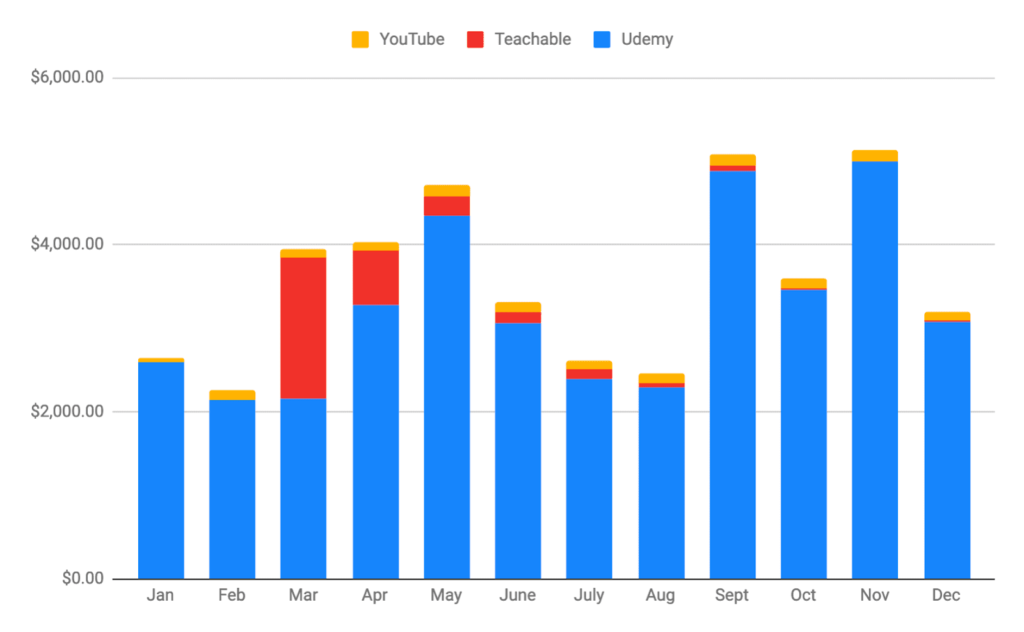
A particularly inspiring case study comes from succulentsandsunshine.com, demonstrating the power of specialized knowledge.
Despite operating in the highly specialized succulent plant niche, this entrepreneur embraced the focused market opportunity rather than viewing it as a limitation. In 2018, Cassidy, who established Succulents and Sunshine, generated $200,000 through her digital platform. While this figure encompasses multiple revenue streams, her educational course contributed significantly to this impressive financial achievement.

Having examined these successful case studies, let’s now explore more representative industry benchmarks.
According to Udemy’s official SEC filing, instructors on their platform earned an average of $2,950 throughout 2020, with more than 9,000 instructors generating revenue exceeding $1,000. When calculating monthly figures, this translates to an average instructor income of approximately $250 per month.

Examining Thinkific’s financial reporting reveals that as of Q2 2021, the platform supported 29,200 paying customers. When calculating the ratio between Thinkific’s gross merchandise volume and their number of paying instructors, the data indicates that course creators utilizing Thinkific’s paid plans generate approximately $1,200 per month on average.
Teachable has also released performance metrics regarding their creator earnings, though these figures warrant careful interpretation. According to their analysis, roughly 64% of what they classify as ‘top schools’ generate monthly revenue exceeding $2,500.

It’s worth noting an important caveat here. Teachable’s analysis exclusively incorporates their highest-performing schools, meaning the actual platform-wide average monthly earnings would be considerably lower.
While online courses offer substantial income potential at the upper end, median instructor earnings remain significantly more modest. This highlights the importance of understanding the critical variables that influence course profitability, which we’ll analyze next.
Multiple variables impact your potential online course earnings. Let’s examine the most significant factors that determine financial outcomes.
The subject matter of your course represents the most influential determinant of revenue potential, with certain topics consistently outperforming others.
As a general principle, educational content that helps students increase their income or reduce expenses demonstrates the highest earning capacity. This explains why business education, personal finance instruction, information technology training, and career advancement courses prove particularly lucrative.
Conversely, topics without clear financial returns typically generate more modest revenues. For instance, even popular courses in hobby categories or pet training generally produce lower income levels.
Market saturation and competitive landscape also require strategic consideration. Digital marketing courses, while indisputably in-demand, exist in a crowded marketplace with thousands of similar offerings, creating significant visibility challenges.
Consequently, targeting specialized sub-niches with more focused content can strategically reduce competition while enhancing differentiation and success probability.
Your pricing strategy significantly impacts your total revenue generation.
This presents a delicate balance—excessive pricing may suppress sales volume, while underpricing might increase enrollments without achieving revenue targets.
The ideal price point should resonate appropriately with your target audience — positioned as premium yet attainable, delivering clear value justification.
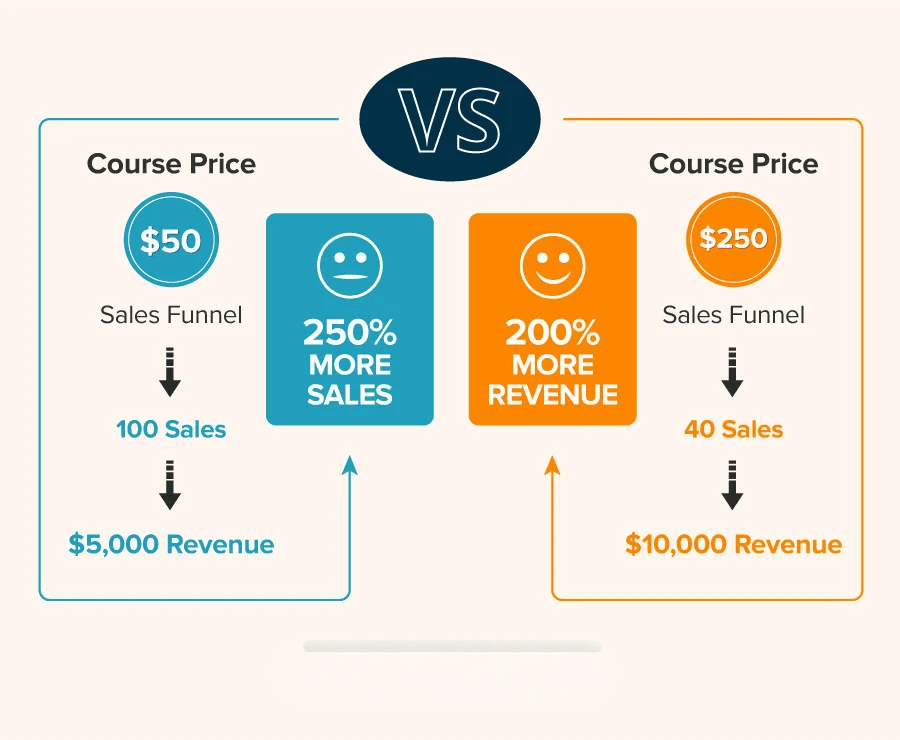
Therefore, invest adequate time conducting comprehensive market research, competitive analysis, and audience profiling before establishing your initial course pricing structure.
Additionally, implement deliberate strategies to enhance your course’s perceived value, enabling premium pricing without negatively impacting your conversion metrics.
The scale of your existing audience represents the most critical determinant of course revenue potential. This audience encompasses your email subscribers, social media following, and professional network.
Without an established audience, generating significant course revenue becomes virtually impossible. In such scenarios, even exceptional niche selection and pricing strategy provide minimal benefit.
Conversely, creators with substantial existing audiences typically achieve considerable revenue from their course offerings.
While additional variables influence your ultimate financial outcomes, an established audience indicates an existing interest base in your expertise, virtually ensuring some level of monetization success.
The final crucial revenue determinant is your conversion rate – the percentage of prospects who complete a purchase throughout your sales funnel.
For example, if your email list contains 1,000 subscribers and your course generates 25 sales, your effective conversion rate equals 2.5%.
To calculate your projected course revenue, multiply three key variables: your total audience reach, your conversion percentage, and your course price point.
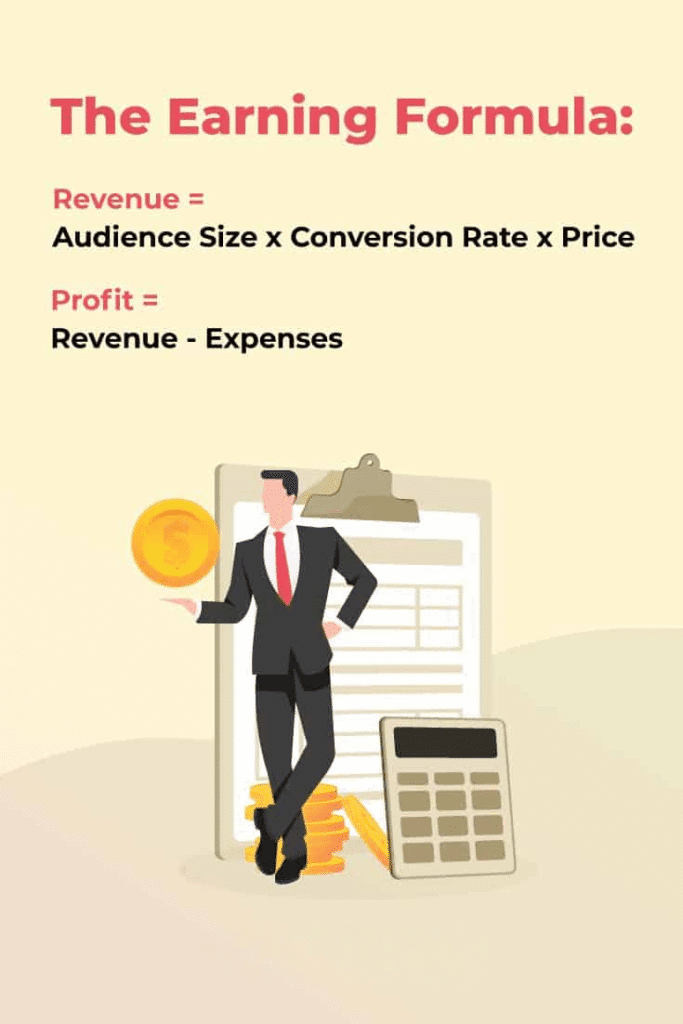
Your specific conversion rate is influenced by multiple elements, including funnel structure, lead magnet quality, email communication effectiveness, audience engagement tactics, and sales page optimization.
To facilitate accurate revenue projections, we’ve developed a comprehensive earnings calculator that estimates your potential course income based on three key variables: pricing strategy, audience reach, and conversion performance.
Conversion metrics for online courses typically vary depending on numerous factors including price positioning, audience relationship quality, and marketing approach. However, these general benchmarks provide useful guidance:
Enter your specific data points in the fields provided below to generate a realistic revenue projection for your online course venture.
$ 5,000
$ 4,000
The calculator results display your anticipated gross revenue as well as projected profits after accounting for course development expenses. For complete financial clarity, remember to deduct your marketing expenditures to determine actual net profit.
Once your course launches successfully and begins gaining momentum, numerous strategies exist to optimize your revenue streams and enhance overall earning potential.
These approaches incorporate both conversion rate improvement tactics and methods for generating supplementary income through complementary products and services.
Rather than simply elevating your price point, I recommend initially concentrating on enhancing your course’s intrinsic value proposition. When your educational offering delivers exceptional value, premium pricing becomes justified and readily accepted.
Certain fundamental elements remain essential for successful course monetization, with course quality representing the most critical component.
The primary quality dimension concerns the substantive value your content delivers. Consider these guiding principles:
The secondary quality dimension involves professional presentation standards. For instance, video content should maintain minimum technical specifications of 1080p resolution. Additionally, investing in professional-grade audio production significantly enhances perceived value.

Beyond core educational content, consider incorporating supplementary value elements into your course offering. Market-leading online courses typically include additional benefits such as dedicated student communities, interactive Q&A sessions, and complementary resource materials.
Consider Stu McLaren’s The Membership Experience as an illustrative example. Participants gain access to an exclusive Facebook community. Furthermore, McLaren conducts daily live sessions throughout the program duration to address student inquiries.
This comprehensive value proposition enables him to successfully market his program at a $2k price point. Fundamentally, enhancing student value across all course elements creates pricing leverage, making this approach essential throughout your course development process.
Implement a tiered pricing structure that presents students with multiple purchase options rather than limiting them to a single offering.
This approach allows participants to select the specific features and support levels that align with their needs by choosing appropriate package configurations. Additionally, you can develop premium enhancements available at supplemental price points that further augment your core offering.
For instance, you might structure a two-tier course model where the foundational level provides access to essential course materials, while the premium tier incorporates personalized group coaching sessions. The premium option naturally commands a higher price point.
Matt Johnson exemplifies this strategy with his video editing curriculum. His Professional tier delivers additional specialized courses and provides access to raw footage materials, positioning it at a $50 premium above his Basic package.
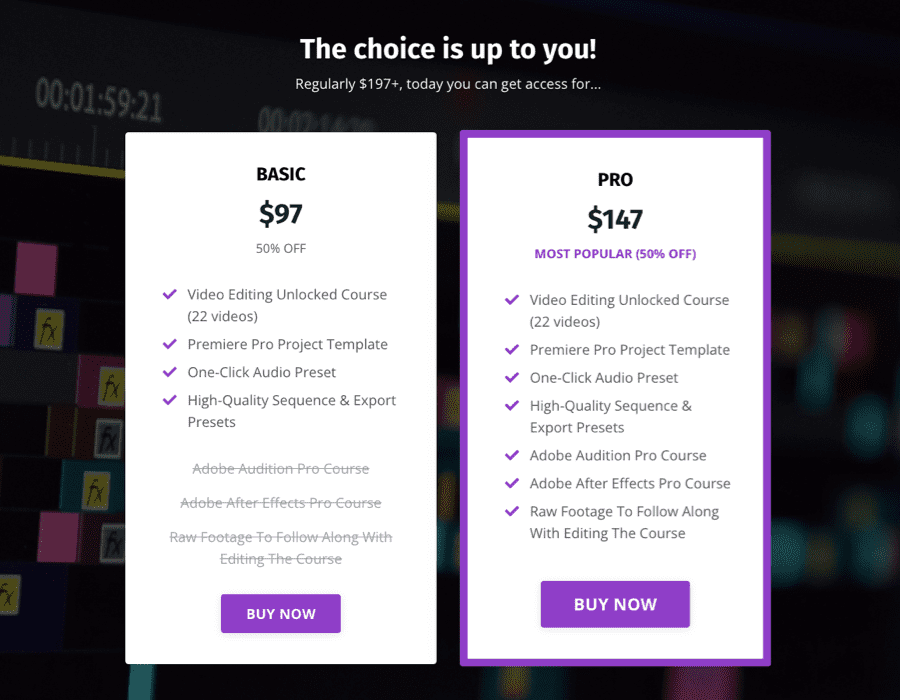
Beyond structured package tiers, strategic post-purchase upsells on confirmation pages present additional revenue opportunities. For instance, if you operate a membership platform, you might offer subscription access on your course completion page.
The fundamental strategy behind upsell implementation focuses on increasing customer lifetime value while enhancing overall business revenue metrics.
Additionally, developing expanded course offerings or evolving your enterprise into a comprehensive online education platform creates substantial pathways for revenue expansion.
Your sales funnel—the structured progression guiding prospects from initial awareness through completed purchase—represents the most critical element in transforming interested individuals into paying customers.
Most successful educators initially attract potential students through complimentary content distribution including blog articles, video tutorials, and podcast episodes. Offering valuable free resources at the funnel entry point establishes your expertise and cultivates audience interest.
Subsequently, implementing a compelling lead generation incentive (such as complementary guides, assessment tools, or resource collections) facilitates email address acquisition, enabling relationship development through strategic, value-focused email communication.
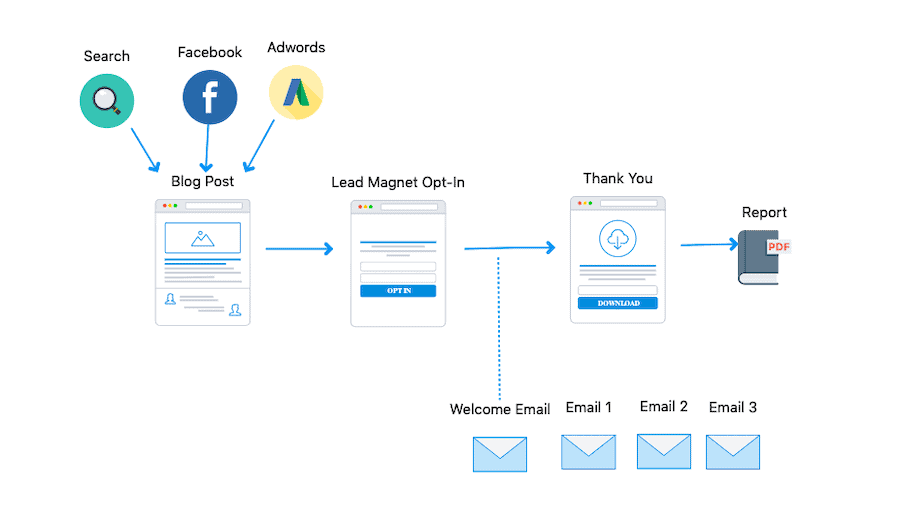
A sample lead magnet to capture leads and cultivate relationships with your potential audience
Moreover, this entire process operates through automation. This highlights the fundamental value of an effective sales funnel — it dramatically reduces time investment while systematically converting prospects.
For those with established funnels, focus on optimizing conversion metrics. Consider these proven enhancement strategies:
While seemingly self-evident, expanding your audience reach remains the most effective strategy for scaling course revenue beyond initial plateaus.
Audience expansion requires consistently introducing new prospects into your conversion funnel through multiple channels.
Begin by maximizing organic traffic sources including search engines (Google), video platforms (YouTube), and social networks (Facebook, LinkedIn). Subsequently, amplify reach through strategic paid acquisition channels such as Google Ads and Facebook Advertising.
An exceptionally effective growth approach involves developing affiliate partnerships with complementary creators who promote your educational content to their established audiences.
The comprehensive implementation of these strategies exceeds our current scope, representing an extensive marketing discipline. For detailed implementation guidance, consult our comprehensive online course marketing resource.
As demonstrated throughout this analysis, numerous course creators generate substantial full-time incomes through digital education. While average creator earnings remain considerably more modest, abundant examples exist of educators generating monthly revenues of $10k or even exceeding $50k.
Your actual revenue potential depends on multiple variables including audience scale, niche selection, course quality, pricing strategy, and marketing approach.
Success requires identifying profitable educational opportunities, developing exceptional content, and implementing effective marketing frameworks.
This comprehensive process demands significant investment, and I recommend exploring our complete guide to creating and marketing online courses as you begin your journey.
We trust this analysis has provided valuable insights regarding online course income potential. Please share any questions or perspectives in the comments section below!
Yes, it is. Selling online courses is one of the best business models that exist. Online learning is a booming market internationally, and more and more people are buying online courses to learn new things, making it a great opportunity for knowledgepreneurs.
While you can make money with courses in any niche, certain niches like technology, business, personal development, and health and wellness are the most profitable ones to create online courses. Check our list to find out the most profitable niches and potential course ideas in each of them.
To create an online course that sells, you need to make sure there is a demand for your course idea. And then, you need to focus on creating high-quality content that your students will love.
There is no exact figure for the average online course revenue. However, we have some platform-specific numbers. The average instructor revenue on Udemy is around $250/month, while the same is around $1,000/month for Thinkific.
Udemy is one of the most popular platforms among online instructors. While many instructors make a six-figure income on Udemy, a majority of instructors make less than $1,000 per year on the platform.
Yes, all online courses and websites created on Kajabi are mobile responsive. Plus, your students can also access your content through a free mobile app.
Based on our estimation study, creating an online course can cost you anywhere between $140 and $10,770. It depends on many things, including course length, video quality, and whether you outsource or not.

Daniel NicFounder, SellingOnliceCoursesGuide.comis an entrepreneur and digital education specialist who founded sellingonlinecoursesguide.com, a platform dedicated to helping creators and educators successfully navigate the online course marketplace. Through his website, he shares insights and strategies for developing, marketing, and monetizing online educational content. His work focuses on empowering course creators to build sustainable online businesses while effectively sharing their knowledge with students worldwide.

Daniel Nic is an entrepreneur and digital education specialist who founded sellingonlinecoursesguide.com, a platform dedicated to helping creators and educators successfully navigate the online course marketplace. Through his website, he shares insights and strategies for developing, marketing, and monetizing online educational content. His work focuses on empowering course creators to build sustainable online businesses while effectively sharing their knowledge with students worldwide.

We respect your privacy and will never spam you.